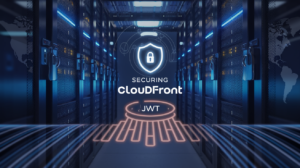Web attacks are getting smarter, and manual security monitoring just can’t keep up anymore. AWS WAF automation offers a powerful solution for security teams, DevOps engineers, and cloud architects who need to protect their applications without constantly babysitting security rules.
This guide walks you through building an automated threat detection system that works around the clock. You’ll learn how AWS WAF setup can be streamlined to catch threats before they reach your applications, and how machine learning cybersecurity takes your defenses to the next level by spotting attack patterns humans might miss.
We’ll cover how to configure smart detection rules that adapt to new threats, implement real-time threat mitigation that responds instantly to suspicious activity, and set up comprehensive monitoring that gives you clear insights into your security posture. By the end, you’ll have a robust cloud security automation system that protects your web applications while freeing up your team to focus on what matters most.
Understanding AWS WAF for Enhanced Security Protection
Core capabilities and threat detection features
AWS WAF automation delivers comprehensive protection through rule-based filtering, SQL injection defense, cross-site scripting prevention, and DDoS mitigation. The web application firewall monitors HTTP/HTTPS requests in real-time, automatically blocking malicious traffic patterns while allowing legitimate users seamless access. Built-in managed rule sets from AWS and third-party security vendors provide instant protection against OWASP Top 10 vulnerabilities. Custom rule creation enables organizations to address specific threats unique to their applications, while rate limiting prevents abuse and resource exhaustion attacks.
Real-time monitoring and traffic analysis benefits
Real-time threat mitigation capabilities allow AWS WAF to analyze incoming requests within milliseconds, making instant blocking decisions before malicious traffic reaches your applications. The system processes millions of requests per second while maintaining low latency for legitimate users. CloudWatch integration provides detailed metrics and logs for traffic patterns, blocked requests, and security events. Automated threat detection algorithms continuously learn from global threat intelligence, adapting protection strategies as new attack vectors emerge across the AWS ecosystem.
Integration advantages with existing AWS infrastructure
AWS WAF seamlessly integrates with CloudFront, Application Load Balancer, and API Gateway without requiring additional infrastructure changes or complex configurations. Native AWS security monitoring works alongside existing services like Amazon GuardDuty, AWS Security Hub, and AWS Config for comprehensive security visibility. IAM policies control access to WAF configurations, while CloudFormation templates enable automated deployment across multiple environments. This tight integration eliminates compatibility issues common with third-party security solutions and simplifies management through unified AWS console access.
Cost-effective security solution compared to traditional methods
Cloud security automation with AWS WAF eliminates expensive hardware purchases, maintenance costs, and dedicated security staff typically required for traditional firewall solutions. Pay-as-you-use pricing means you only pay for requests processed and rules evaluated, making it cost-effective for businesses of any size. Managed rule sets reduce the need for specialized security expertise while providing enterprise-grade protection. The service scales automatically during traffic spikes without additional infrastructure investments, delivering consistent protection during peak usage periods without performance degradation or unexpected costs.
Setting Up Automated Threat Detection Rules
Creating custom rules for specific attack patterns
Building effective AWS WAF automation starts with creating targeted rules that address your application’s unique vulnerabilities. Custom rules allow you to define specific conditions and actions based on HTTP request components like headers, query strings, and request bodies. You can craft rules that detect suspicious patterns in user agents, unusual request frequencies from single IP addresses, or malformed requests attempting to exploit known vulnerabilities. The rule builder provides regex pattern matching, string comparisons, and logical operators to create precise detection criteria. Testing these rules in count mode before enabling blocking ensures accuracy and prevents legitimate traffic disruption.
Implementing rate-limiting to prevent DDoS attacks
Rate-limiting rules form the backbone of DDoS protection within AWS WAF setup, automatically identifying and blocking excessive requests from individual sources. Configure rate-based rules to monitor requests per 5-minute window from single IP addresses, with thresholds typically ranging from 2,000 to 10,000 requests depending on your application’s normal traffic patterns. Advanced configurations can track rates across different request characteristics like specific URI paths, query parameters, or geographic regions. Combine rate limiting with temporary IP blocking to create escalating responses that automatically lift restrictions after attack patterns subside, maintaining service availability while protecting infrastructure resources.
Configuring IP reputation and geo-blocking filters
IP reputation filtering leverages AWS’s threat intelligence feeds to automatically block requests from known malicious sources, including compromised machines, tor exit nodes, and command-and-control servers. Geo-blocking rules restrict access based on country-level geographic locations, useful for applications serving specific regions or complying with data sovereignty requirements. Configure these filters through AWS Managed Rules or create custom geographic restrictions using ISO country codes. Real-time updates ensure your protection stays current with emerging threats, while allowlisting capabilities prevent blocking legitimate users from restricted regions who require access for business purposes.
Establishing SQL injection and XSS protection rules
SQL injection and cross-site scripting protection requires comprehensive rule sets that examine request bodies, query strings, and headers for malicious code patterns. AWS Managed Rules provide pre-configured OWASP Top 10 protections, automatically updated with new attack signatures and evasion techniques. Custom rules can target application-specific injection points, such as search parameters, form fields, or API endpoints that handle user input. Configure sensitivity levels to balance protection with false positive rates, and implement logging to analyze blocked requests for rule refinement. These automated threat detection capabilities continuously monitor incoming traffic without requiring manual intervention.
Setting up bot detection and management policies
Bot management policies distinguish between legitimate automated traffic and malicious bots attempting scraping, credential stuffing, or application-layer attacks. AWS WAF’s bot control managed rule group automatically categorizes traffic into verified bots (search engines), unverified bots, and targeted bots based on behavioral analysis and machine learning models. Configure different actions for each category – allowing search engine crawlers while challenging or blocking suspicious automated traffic. Advanced configurations can whitelist specific user agents, implement CAPTCHA challenges for borderline cases, and create custom rules for application-specific bot behaviors like API rate limiting or session management.
Leveraging Machine Learning for Advanced Protection
Enabling AWS Managed Rules for intelligent threat detection
AWS Managed Rules transform your web application firewall into a smart security powerhouse by using pre-built rule sets powered by machine learning algorithms. These rules automatically identify and block common attack patterns like SQL injection, cross-site scripting, and bot traffic without manual configuration. The intelligent threat detection system continuously updates based on global threat intelligence, ensuring your applications stay protected against emerging vulnerabilities. You can easily enable Core Rule Set, Known Bad Inputs, and IP Reputation rules through the AWS console, providing immediate protection against OWASP Top 10 threats and other sophisticated attack vectors.
Utilizing anomaly detection for unknown attack vectors
Machine learning cybersecurity capabilities in AWS WAF excel at identifying suspicious behavior patterns that traditional signature-based systems miss. The anomaly detection feature establishes baseline traffic patterns for your applications and automatically flags deviations that could indicate zero-day exploits or advanced persistent threats. This proactive approach catches attackers who use custom tools or modify existing attack methods to bypass conventional security measures. The system learns from legitimate user behavior, reducing false positives while maintaining high sensitivity to genuine threats that haven’t been seen before.
Implementing adaptive security based on traffic patterns
Traffic pattern analysis enables AWS WAF automation to dynamically adjust security postures based on real-time conditions and historical data. The system recognizes normal traffic flows during different times of day, geographic locations, and user behaviors to create adaptive rule thresholds. During suspected attack scenarios, the firewall automatically tightens security controls, while loosening restrictions during verified legitimate traffic spikes. This intelligent adaptation prevents both successful attacks and service disruptions, ensuring your web applications remain accessible to genuine users while blocking malicious actors attempting to exploit your infrastructure.
Implementing Real-Time Response and Mitigation
Configuring Automatic Blocking of Malicious Requests
AWS WAF automation enables immediate blocking of suspicious traffic through predefined rule conditions. Configure rate-based rules to automatically block IP addresses exceeding request thresholds, typically 2,000 requests per 5-minute window. Set up geo-blocking rules to restrict access from high-risk countries and implement SQL injection protection using AWS managed rule groups. Custom string match conditions can block requests containing malicious patterns in headers, URIs, or query parameters. Enable CloudWatch integration to trigger automatic IP blocking when threat patterns emerge.
Setting Up Alert Notifications for Security Incidents
Real-time threat mitigation requires robust notification systems for security teams. Configure Amazon SNS topics to send instant alerts when AWS WAF blocks suspicious requests or detects attack patterns. Set up CloudWatch alarms with custom thresholds – trigger alerts when blocked requests exceed 100 per minute or when specific rule groups activate frequently. Integrate with Slack, PagerDuty, or email systems for immediate incident response. Create different alert severities based on threat types: critical alerts for DDoS attempts, medium alerts for bot traffic, and low alerts for common web exploits.
Creating Custom Responses for Different Threat Levels
Develop tiered response strategies based on threat severity and business requirements. For low-level threats like basic bot traffic, implement CAPTCHA challenges using AWS WAF’s challenge action. Medium-threat scenarios warrant temporary IP blocking with custom error pages explaining the security measure. High-severity threats such as DDoS attacks require immediate blocking with minimal server resources consumed. Configure custom HTTP response codes (403, 429, or 503) with informative messages that don’t reveal security mechanisms. Use count actions for monitoring suspicious patterns before escalating to blocking measures.
Establishing Fallback Mechanisms for False Positives
Protect legitimate users from overzealous security measures through intelligent fallback systems. Implement whitelist rules for trusted IP ranges, including office locations, partner networks, and known good user agents. Set up time-based rules that temporarily bypass certain restrictions during maintenance windows or high-traffic events. Create manual override capabilities allowing security teams to quickly unblock legitimate traffic. Establish automated false positive detection using machine learning insights from AWS WAF logs, automatically adjusting rule sensitivity when legitimate traffic patterns emerge. Configure graduated response mechanisms that escalate blocking measures only after multiple violations.
Monitoring and Analytics for Continuous Improvement
Utilizing CloudWatch metrics for performance tracking
CloudWatch provides essential metrics for AWS WAF automation, tracking blocked requests, allowed traffic patterns, and rule performance in real-time. Monitor request rates, geographic distributions, and threat detection effectiveness through detailed dashboards that reveal attack vectors and security posture improvements across your web applications.
Analyzing web ACL logs for threat intelligence
Web ACL logs contain valuable threat detection analytics that help identify emerging attack patterns and malicious IP addresses. Parse log data to understand attacker behavior, analyze blocked requests by rule type, and extract actionable intelligence for refining your automated threat detection rules and improving overall security effectiveness.
Creating custom dashboards for security visibility
Build comprehensive security dashboards combining AWS WAF metrics, CloudWatch data, and threat intelligence feeds to maintain complete visibility into your security posture. Custom visualizations display attack trends, rule effectiveness, and performance metrics, enabling security teams to quickly identify threats and make data-driven decisions for continuous improvement.
Generating compliance reports for audit requirements
Automated reporting systems pull AWS security monitoring data to generate compliance documentation for regulatory audits and internal security assessments. Configure scheduled reports that document threat mitigation activities, security rule changes, and incident response metrics, ensuring your organization meets audit requirements while maintaining detailed security records.
Optimizing Performance and Cost Management
Fine-tuning Rules to Reduce False Positives
Start with broad threat detection patterns, then gradually refine your AWS WAF rules configuration based on legitimate traffic patterns. Monitor blocked requests daily and whitelist trusted IP ranges, user agents, and geographic locations that generate false alarms. Create custom rules that examine multiple request attributes simultaneously rather than relying on single-parameter matches. Test rule changes in count mode before switching to block mode, allowing you to observe potential impacts without disrupting user experience.
Balancing Security Coverage with Request Processing Speed
Optimize rule ordering by placing the most frequently triggered rules at the top of your rule groups, reducing processing time for common threats. Keep your rule sets lean by removing redundant or overlapping conditions that create unnecessary computational overhead. Use AWS WAF’s managed rule groups selectively rather than enabling every available protection, focusing on threats most relevant to your application. Implement rate limiting rules strategically to prevent abuse while maintaining smooth performance for legitimate users during peak traffic periods.
Managing AWS WAF Costs Through Efficient Rule Configuration
Monitor your AWS WAF automation costs by tracking web ACL evaluations and rule group usage through CloudWatch metrics. Consolidate similar protection logic into fewer, more comprehensive rules rather than creating multiple narrow-scope rules that increase evaluation costs. Use AWS WAF’s capacity units efficiently by prioritizing high-impact security rules and removing low-value protections that consume significant resources. Set up cost alerts to track monthly WAF expenses and regularly audit your rule configurations to eliminate unused or ineffective security policies.
AWS WAF offers a powerful way to protect your web applications from cyber threats without breaking the bank or requiring a dedicated security team. By setting up automated detection rules, using machine learning capabilities, and implementing real-time responses, you can create a robust defense system that works around the clock. The monitoring and analytics features help you stay on top of emerging threats while keeping your costs under control.
The key to success with AWS WAF lies in starting simple and building up your defenses over time. Begin with basic rules, monitor what’s happening, and gradually add more sophisticated protections as you learn what works best for your specific setup. Don’t forget to regularly review your rules and performance metrics to make sure you’re getting the most out of your investment while keeping the bad guys at bay.













